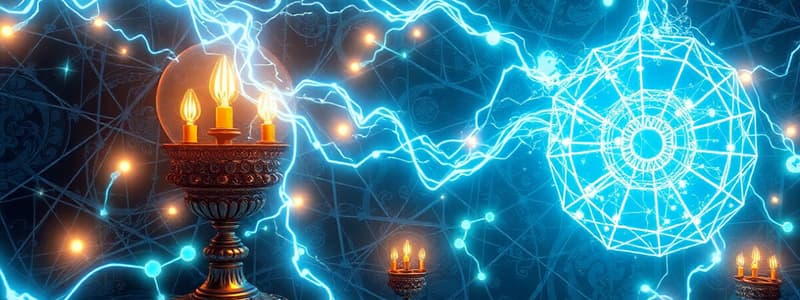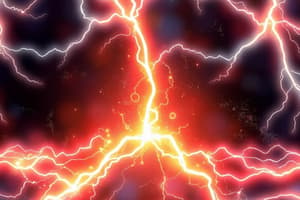Podcast
Questions and Answers
What phenomenon occurs when synthetic clothes create a spark or crackling sound?
What phenomenon occurs when synthetic clothes create a spark or crackling sound?
- Static friction
- Electric discharge (correct)
- Thermal expansion
- Magnetic induction
What did Thales of Miletus discover about amber and wool or silk?
What did Thales of Miletus discover about amber and wool or silk?
- Amber generates heat when rubbed with wool.
- Amber emits light when rubbed with any material.
- Amber attracts light objects when rubbed with wool or silk. (correct)
- Amber repels light objects when rubbed.
What causes the sensation of shock when touching a metal surface after sliding on a bus?
What causes the sensation of shock when touching a metal surface after sliding on a bus?
- Change in temperature
- Ionization of the air
- Discharge of accumulated electric charges (correct)
- Chemical reaction with the surface
The term 'electricity' is derived from which Greek word?
The term 'electricity' is derived from which Greek word?
During which weather condition are electric discharges like lightning more frequently observed?
During which weather condition are electric discharges like lightning more frequently observed?
What occurs when two like charges are brought close together?
What occurs when two like charges are brought close together?
What type of charge does a glass rod acquire when it is rubbed with silk?
What type of charge does a glass rod acquire when it is rubbed with silk?
Which of the following materials is considered an insulator?
Which of the following materials is considered an insulator?
What happens to the charges when two charged bodies are brought into contact?
What happens to the charges when two charged bodies are brought into contact?
Which scientist named the charges on glass and plastic materials?
Which scientist named the charges on glass and plastic materials?
Flashcards are hidden until you start studying
Study Notes
Electric Charge
- Static electricity describes the build-up of electric charges on a surface.
- A glass rod rubbed with silk acquires a positive charge, while the silk acquires a negative charge.
- A plastic rod rubbed with fur acquires a negative charge, while the fur acquires a positive charge.
- The charge of an object can be neutralized by bringing it into contact with another object with an opposite charge.
- Like charges repel each other and unlike charges attract each other.
Conductors and Insulators
- Conductors allow electric current to flow easily, while insulators resist the flow of electric current.
- Metals are good conductors, while glass, porcelain, plastic, and wood are good insulators.
- On conductors, charge quickly spreads over the entire surface.
- On insulators, the charge remains localized.
Semiconductors
- Semiconductors have conductivity between conductors and insulators.
- They are used in electronic devices such as transistors and diodes.
Electroscope
- A gold-leaf electroscope is used to detect the presence of charge on an object.
- When a charged object is brought near the electroscope, the gold leaves diverge, indicating the presence of charge.
Charging of Bodies
- To charge a neutral body, either add or remove electric charge.
- A body can be charged positively by losing electrons.
- A body can be charged negatively by gaining electrons.
- When rubbing a glass rod with silk, the rod becomes positively charged and the silk negatively charged.
- This is because some electrons are transferred to the silk.
- No new charge is created in the process; electrons are simply transferred.
Studying That Suits You
Use AI to generate personalized quizzes and flashcards to suit your learning preferences.




